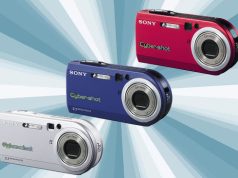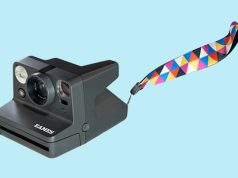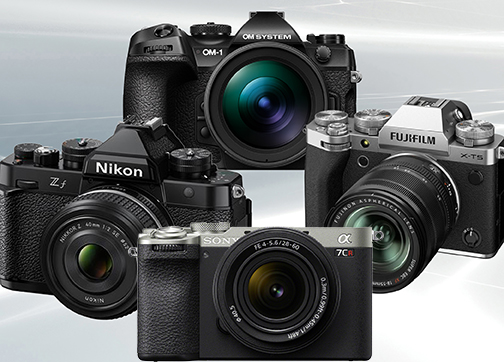
Enthusiasts are photographers dedicated to creative expression, visual communication and creating images and videos that stand the test of time. Perhaps that’s why so many of today’s enthusiasts are now gravitating toward higher-end mirrorless cameras with pro-level feature sets. These full-featured mirrorless cameras maximize their creative potential and provide a more fulfilling, immersive shooting experience than middle-tier models.
Indeed, most of the cameras we selected here fall into the $2,200–$3,000 price range. The remaining are in the in the $1,700–$2,000 range. This is an indication that enthusiast shooters are passionate about creating high-quality images and videos. Today’s enthusiasts also demand advanced multimedia and pro-caliber video capability. That means cameras that can capture 4K UHD and/or DCI, 6K or 8K video at 30 or 60 frames per sec. They also provide Log Gamma output and HLG (Hybrid Log Gamma or HDR, high dynamic range). Thus, you can have an extended tonal range in postproduction.
As expected, tech specs—including framing rates; EVF (electronic viewfinder) and LCD resolution; AF speed and accuracy; ISO ranges; etc.—were all noticeably upgraded in the past two years. Further, high-end video capability now trumps even the sensor’s megapixel rating in many cases.
Finally, today’s enthusiasts are open to a variety of formats, including full frame, APS-C and MFT (Micro Four Thirds). Thus, a camera’s form factor, ergonomics and compactness often factor into the decision process when it comes to choosing the right camera. All the cameras here are outstanding choices for enthusiasts. We hope this selection inspires you to check out the other cameras in this category as well.
Full-Featured Mirrorless Cameras for Enthusiasts
Sony Alpha 7CR
Considering all the processing and resolving power packed into this top-tier Sony mirrorless camera, you’ll understand why it’s the choice of many enthusiasts. Optimized for all-day shooting, it boasts a smaller, lighter body than previous Alphas. Key is its 61-megapixel, full-frame Exmor R BSI CMOS sensor coupled with a Bionz XR image processor. Its outstanding performance parameters include 8-fps, full-res bursts with the mechanical shutter and 7 fps with the electronic shutter. Moreover, both employ full-time AF/AE.
The camera also boasts JPEG capture for 1,000 frames and 14-bit, high-res 61MP stills at a native sensitivity range of ISO 100–32,000. This is expandable from ISO 50 to 102,400. Plus, it features a very wide 15-stop dynamic range.
Video capabilities include 10-bit, full-frame 4K 60p recording. What’s more, it condenses high-res video data equivalent to 7K/6K to output 4K video. Other video specs include XAVC HS 4:2:2/4:2:0 10-bit recording at 24/50/60 fps and XAVC S 4:2:2/4:2:0 8/10-bit recording at 24/25/30/50/60/120 fps. S-Log3, S-Gamut3 and S-Cinetone enable comprehensive tonal adjustments.
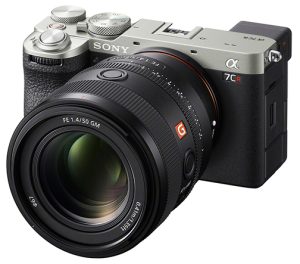
Also notable is 5-axis in-body image stabilization (IS) with 7 stops of shake-effect reduction. Additionally, Pixel Shift Multi Shooting tech works with the system to create composite images of 240MP. Plus, a hybrid AF system with AI-based autofocus provides real-time recognition AF for seven selectable target types. It also has 693 phase-detection points covering 79% of the image.
There’s also a 2.4M-dot electronic viewfinder with .70x magnification and a 120-fps mode for tracking moving subjects. Plus, a side-opening, vari-angle, 3-inch, 1.04M-dot LCD has touch capabilities. The ILC also provides Wi-Fi on 2.4/5 GHz bands and Bluetooth 4.2 for comprehensive wireless connectivity. Additionally, there’s a SD/SDHC/SDXC (UHS-II) memory card slot. The camera’s durable magnesium alloy body is well sealed against dust and moisture for shooting in harsh environments. $2,999.99.*
Nikon Z 7II
Nikon’s exceptional, high-spec mirrorless full framer looks ruggedly handsome and purposeful. The second-gen ILC is based on a 45.7MP FX-format BSI (backside-illuminated) CMOS sensor that omits the low-pass filter. Coupled to dual Expeed 6 image processors, the high-tech combo delivers impressively upgraded speed and performance.
The Z 7II can record 4K UHD video at 60 fps, capturing an enhanced dynamic range in both stills and video. It also records externally in 10-bit using N-Log or HLG and outputs via HDMI. Furthermore, its native sensitivity settings from ISO 64 to 25,600 are expandable from ISO 32 to 102,400. It also provides an impressive full-resolution burst rate of up to 10 frames per sec.

Another high-end feature is its 493-point phase-detection autofocus system. Moreover, the AF system was upgraded to support eye-detection AF for humans and animals in wide-area AF modes and during video recording. Further, it focuses swiftly in low light, down to -4.5 EV. The Z 7II also has built-in 5-axis VR (vibration reduction) image stabilization to minimize the effects of handheld camera shake.
Viewing options include a 0.8x 3.7M-dot EVF as well as a 3.2-inch, 2.1M-dot, tilting touchscreen LCD. Additionally, there is a top panel dot-matrix OLED display. The Z 7II provides memory card slots for SD UHS-II as well as CFexpress Type B/XQD cards. Other features include an 8K time-lapse mode as well as built-in Wi-Fi, Bluetooth and SnapBridge connectivity. Nikon houses all this tech in a robust, weather-sealed body with a magnesium alloy chassis. $2,299.95.
Sigma fp L
Yes, this upgrade of the revolutionary Sigma fp toes the line between pro-level features and enthusiast-aimed parameters. Both sets of photographers will find it appealing. Sigma’s diminutive mirrorless ILC adds an array of advanced features that many fans of the unique ultracompact, modular full framer were seeking. However, it still has a distinctive minimalist form factor as well as the L mount.
In addition, the fp L incorporates an upgraded, ultrahigh-res 61MP, full-frame BSI Bayer CMOS sensor (up from 24.6 MP). It also features a high-sensitivity (down to -5 EV!) hybrid phase- and contrast-detection AF system with 49 contrast-detection and 42 selectable points.
Further, it accepts Sigma’s EVF-11 electronic viewfinder (sold separately). The EVF employs a 0.5-inch, 3.7M-dot OLED panel for eye-level viewing at 0.83x magnification. Plus, it tilts upward 90° for low-angle shooting. It also incorporates its own USB-C port and a 3.5mmn headphone port for audio monitoring.
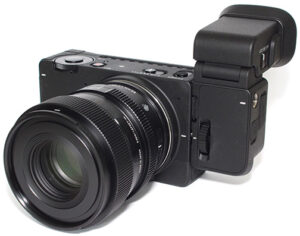
The fp L’s Bayer sensor can capture high-res DNG and JPEG stills in 14-bit as well as record 4K UHD video at 30p, with 12-bit raw output when recording externally. It will also record and output 8-bit Cinema DNG files. What’s more, the fp L provides native sensitivity settings of ISO 100–25,600 that are extendable from ISO 6 to ISO 102,400.
Other key features are a 3.1-inch, 2.1M-dot LCD monitor; a crop zoom function that allows up to a 5x crop; and a maximum full-res burst rate of up to 10 fps. There’s also a slot for SD/SDHC/HDXC (UHS II) cards. The camera’s diecast, weather-resistant body measures only 4.4×2.8×1.8 inches and weighs in at a slight 15.1 ounces (with battery/SD card). $2,499 body only; with EVF-11, $2,999.
Canon EOS R6 Mark II
Canon’s multitalented, second-generation R6 is a full-frame mirrorless camera aimed at enthusiasts. It’s especially appealing to multimedia creators wanting pro-caliber video capability. The “hybrid” ILC pairs a 24.2MP CMOS sensor with the most advanced Digic X image processor.
Consequently, the camera offers improved AF; 4K 60p 10-bit video recording; and a full-res burst rate of 12 fps (40 fps when using the very quiet electronic shutter). Additionally, its 30-fps RAW burst mode starts recording 0.5 sec before you press the shutter release. And, the ILC has sensitivity settings from ISO 100 to 102,400. You can also extend that up to ISO 204,800.

The R6 Mark II also records FHD 120p 10-bit internal video using the full width of its sensor. Moreover, it works with 10-bit sampling and Canon C-Log 3 as well as provides HDR-PQ recording for in-camera HDR production. External recording via the micro-HDMI port also achieves clean 6K output at up to 60 fps.
Further, Canon’s Dual Pixel CMOS AF II tech boasts 1,053 selectable phase-detection AF points that cover the entire field of view. It uses deep learning to constantly improve subject tracking and AF speed. What’s more, a 5-axis in-body image stabilizer (IBIS) sensor-shift IS system affords 8 stops of shake correction. It also works in conjunction with the in-lens IS systems in Canon RF and adapted EF lenses. Add to that movie IS for steadier video.
Another feature is a 0.5-inch, 3.7M-dot EVF with a 120-fps refresh rate. It’s complemented by a 3-inch, 1.6M-dot vari-angle touchscreen LCD that facilitates vlogging and high- and low-angle shooting. The EOS R6 Mark II incorporates Wi-Fi 2.4/5 GHz and Bluetooth wireless connectivity and has dual SD UHS-II card slots. For working in challenging conditions, it features a durable weather-sealed body with ergonomic controls. $2,299.
Panasonic Lumix S5 IIX
This is Panasonic’s outstanding second-generation S series Lumix. It was designed for content creators requiring top-notch still, video and livestreaming capabilities in a compact, ergonomic, full-frame mirrorless camera. A great choice for emerging and experienced enthusiasts, it’s the first Lumix to offer phase-hybrid AF using an updated processing engine with L2 technology to provide faster, more precise autofocus.
The processor integrates with a 24.2MP, full-frame CMOS sensor to provide a maximum full-res burst rate of up to 9 fps for 200 frames (RAW) with the mechanical shutter and 30 fps for 200 frames (RAW) with the electronic shutter. The L-mount camera also records 6K 30p video with 4:2:0 10-bit color for up to 30 minutes; unlimited 4K DCI and UHD 60p 10-bit video; as well as 120p video for slow motion effects. Further, Panasonic preinstalled V-Log, HLG and Cinelike D2/V2 to capture a flat, neutral gamma curve.
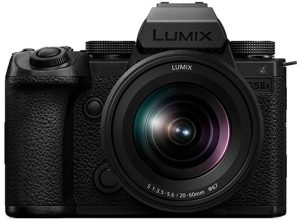
In addition, dual native ISO helps to achieve an optimal balance between noise and sensitivity. It has a range of ISO 100–51,200, expandable from ISO 50 to 204,800. The ILC also captures an impressive dynamic range of 14+ stops. And it provides a unique 96MP high-res shot mode.
The Lumix S5 IIX’s AF system uses 779 phase-detection points for advanced subject tracking. Moreover, 5-axis sensor shift IS achieves a 6.5-stop anti-shake advantage, which increases when using compatible L-mount lenses with built-in optical IS. Other features include a 3.7M-dot OLED live viewfinder with 0.78x magnification, as well as a 3-inch, 1.84M-dot, free-angle touchscreen LCD for live view shooting and menu navigation. It also incorporates dual SD card slots (both UHS-II compatible); has multiple style modes; and offers built-in Wi-Fi and Bluetooth connectivity. It’s all house in a robust magnesium alloy body. $2,499.99.
Nikon Z f
This retro beauty combines the styling and “metal feel functionalism” of a vintage SLR with the modern capabilities of today’s full-frame mirrorless cameras. Reminiscent of the classic Nikon FM2, its outer body is crafted from precision-machined aluminum. Moreover, engraved dials provide traditional manual control options, and its shutter fires with an audible click. It also has a dedicated black-and-white mode with two monochrome options accessed at the press of a finger. And the Z f is the first Nikon camera capable of pixel-shift shooting to creates 96MP images.
Moreover, its prism-shaped top housing contains an EVF that’s manipulated via the 3.2-inch, 2.1M-dot articulating touchscreen. Consequently, users can move focus points, select a subject to track and toggle between display modes—all with the eyepiece. Or they can shoot selfies using the LCD’s front-facing option.

The camera is built around a 24.5MP FX-format BSI CMOS sensor and an Expeed 7 processor. They enable 4K video at 24/25/30,50/60 fps oversampled from 6K. The ILC also records Full HD video at up to 120p for slow motion effects. Plus, it’s capable of in-camera 10-bit H.265 recording. As a result, you can record full-scale video without an external recorder. It also has an ISO 100–64,000 range for stills and ISO 100–51,000 for video. Both expand to ISO 204,800. Plus, full-res bursts top out at 30 fps in silent mode and 14 fps in normal mode using the mechanical shutter.
More High Tech
Moreover, its intelligent AF system with deep learning and eye-detection AF has 273 phase- and contrast-detection points. It recognizes various common subjects, such as people, animals and cars. Further, in-body 5-axis, sensor-shift VR compensates for an impressive 8 stops of shake. It also applies focus point vibration reduction to the area around the active focus point.
Another notable feature is a pre-release function that starts recording 30 JPEGs a second before the shutter is release. Other features include 2.4/5 GHz Wi-Fi; Bluetooth 5.0; and dual card slots, one for SD/SDHC/SDXC (UHS-II) cards, the other for microSD/microSDHC/microSDXC (UHS I) cards. With a magnesium alloy chassis, its body is dust and weather resistant. $1,999.95.
OM System OM-1 Mark II
The OM-1 was named in honor of the classic Olympus OM-1 35mm SLR that debuted 50+ years ago. This iteration is the flagship Micro Four Thirds ILC from OM Digital Solutions. With styling linking it with the past, it offers a completely modern feature set. Thus, it delivers impressive performance in an elegant, compact, ergonomic form factor.
It employs a 20MP, stacked BSI Live MOS MFT sensor and a TruePic X processor. They enable the OM-1 to achieve full-res bursts at 10 fps and up to 120 fps without AF/AE using its electronic shutter. The camera also records 4K DCI/UHD 60p 10-bit video with 4:2:0 sampling. And it captures Full HD video at up to 240 fps. Other video benefits include 12-bit raw output via a Micro HDMI port; HLG mode for in-camera HDR; and OM-Log Gamma for postproduction color grading.
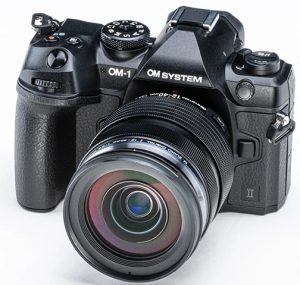
Additionally, ISO settings of 200–25,600 reach 80–102,400 in extended mode. What’s more, it has an advanced autofocus system with Cross Quad Pixel Phase-Detection AF technology. It splits each pixel into four sub-pixels for improved performance in tricky light. And its 1,053 points cover the sensor, perform at 120 fps and boast improved human AI subject detection. It works with 5-axis in-body IS that provides an 8.5-stop advantage in minimizing the effects of shake.
Notable are high-res shot functions that combine 12 frames into one 50MP image in handheld high-res mode and 80MP in tripod high-res tripod mode. Moreover, live ND simulates GND8 and ND128 filtering. Plus, a live composite function enables long exposures, nighttime shooting as well as light painting.
The OM-1 incorporates a 5.8M-dot, 0.83x magnification EVF and a vari-angle, 3-inch, 1.6M-dot touchscreen. The ILC’s weather-, freeze- and splash-resistant magnesium alloy body has rubberized dials for a tactile feel—and an IP5 rating. $2,399.99.
Sony Alpha 7C II
This compact Sony full-frame ILC is, like its acclaimed predecessor, based on a hybrid concept with exciting performance parameters for still and video applications. And it does so in an unintimidating “everyday” form factor. Its 33MP Exmor R BSI CMOS image sensor links to a state-of-the-art Bionz XR processor. The result is the ability to record 10-bit, full-frame 4K 30p video (up to 60p with a Super 35 crop); 10-bit 4:2:2 using the advanced XAVC S-1 format for 4K video at 24/25/30/60 fps; as well as quality bit rates up to 600Mb/s. Further, it records Full HD video at up to 120 fps for slow motion effects.
Moreover, the ILC offers extensive customizable color and gamma controls. They include S-Log-3, S-Gamut3 and Sony S-Cinetone plus user-created LUTs. The E-mount camera also captures 14-bit high-resolution stills, with a 15-stop dynamic range. What’s more, sensitivity settings are extendable from ISO 50 to ISO 204,800 for stills. The camera also delivers a full-res continuous burst rate up to 10 fps.
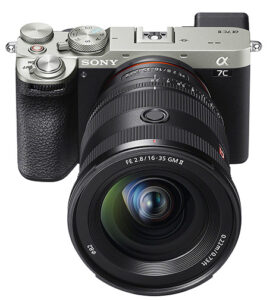
Additionally, an on-sensor Fast Hybrid AF system employs 759 phase-detection points covering an impressive 94% of the format-detection points. It, too, supports real-time eye AF and tracking AF with a built-in AI processing unit. It also has 5-axis in-body sensor shift IS that provides a 7-stop advantage in suppressing the effects of camera shake.
Other key features comprise an offset 0.39-inch, 2.4M-dot, 0.7x magnification OLED EVF; a 3-inch, 1.04M-dot, side-opening, variable-angle LCD touchscreen; built-in 802.11a/b/g/n/ac Wi-Fi on 2.4/5 GHz bands; Bluetooth 4.2; and a single SD slot compatible with all SD UHS-II memory cards. Moreover, the Alpha 7C II is about 20% smaller and lighter than other 7-series Sony cameras, and its weather-sealed body is built on a robust magnesium alloy chassis. $2,199.99.
Fujifilm X-T5
Here’s an attractive, high-spec mirrorless compact ILC from Fujifilm. It features a newly developed 40.2MP APS-C DX-Trans CMOS 5 HR BSI sensor. The sensor works with an advanced X-Processor 5 image processor. This high-tech duo enables impressive still and movie capabilities. For instance, the X-T5 records 4K 60p and 6.2K 30p 4:2:2 10-bit internal video. Plus, it records 12-bit ProRes Raw and Blackmagic Raw via HDMI.
There’s also a 4K HQ mode that oversamples 6.2K footage for superior 4K output. And external F-Log and F-Log2 recordings are possible, the latter providing a 13+ dynamic range. For still images, it achieves full-res bursts of 20 fps with the electronic shutter and 15 fps with the mechanical shutter. Furthermore, sensitivity settings of ISO 125–12,800 in photo and video modes extend from ISO 80 to 51,200 in manual and auto (ISO 125–25,600 for video).
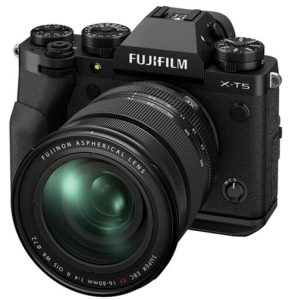
The X-T5 also employs an intelligent hybrid AF system with 425 phase-detection points that’s sensitive to -7 EV for low-light work. And an AI adaptive algorithm automatically tracks active subjects, including animals, athlete and cars. Augmenting this is in-body image stabilization (IBIS) with a 5-axis sensor shift system that reduces the effects of shake by 7 stops for stills and video.
Additionally, Fujifilm’s Pixel Shift Multi-shot tech records 20 images that are combined into a detail-rich 150MP image file using integrated Pixel Shift Combiner software. And for film fans, the ILC offers various film simulation modes, including Provia, Velvia, Astia and black-and-white emulsions.
The Fujifilm X-T5 has a 0.5-inch, 3.7M-dot, 0.8x magnification eye-level EVF along with a 3-inch, 1.8M-dot, tilting touchscreen LCD. It also features built-in Wi-Fi and Bluetooth 4.2 connectivity, plus dual SD/SDHC/SDXC (UHS-II) slots. The X-T5 has a dust- and moisture-resistant body with a magnesium alloy chassis. $1,699.95.
*All SRPs are body only unless otherwise specified.


